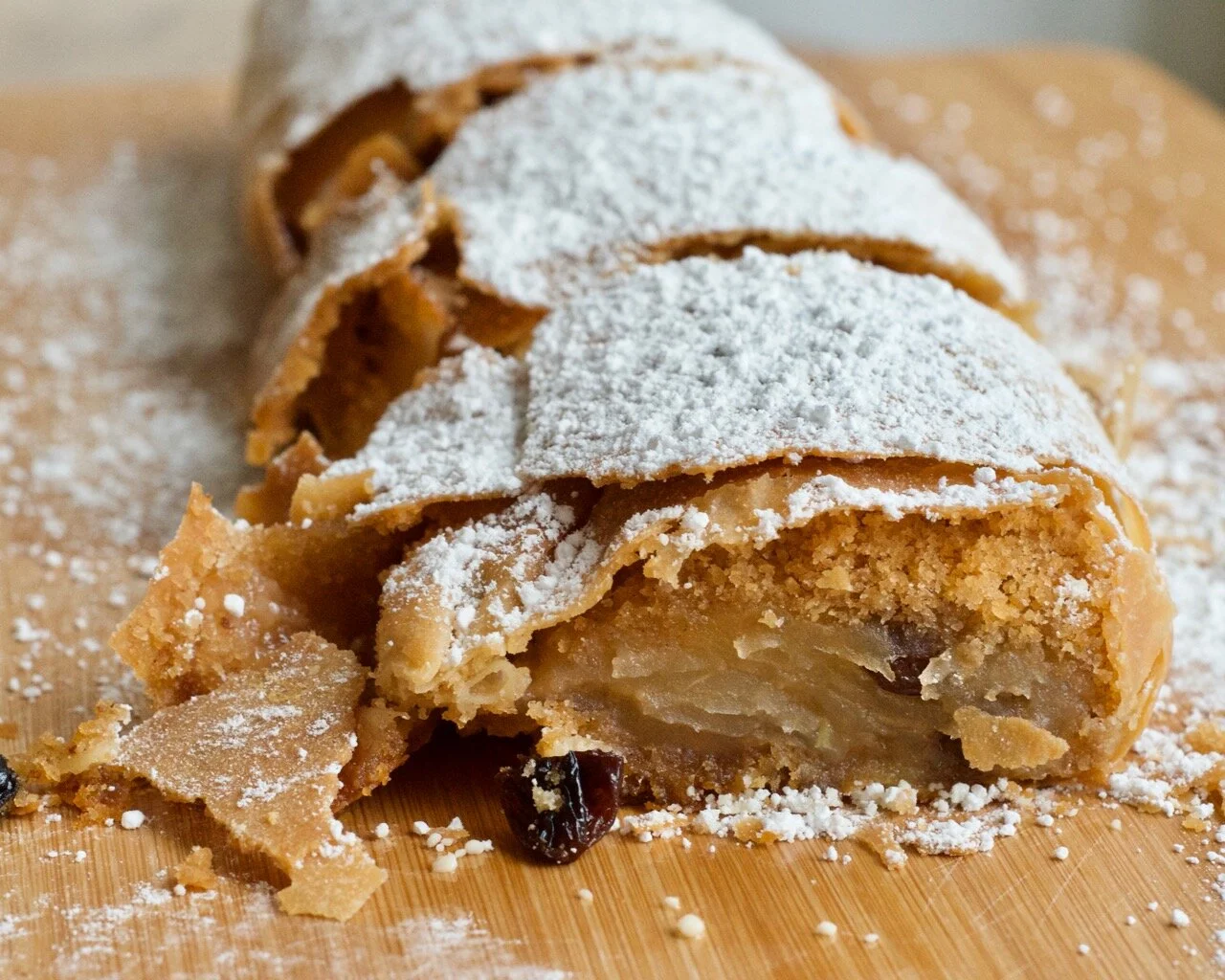flaky austrian apple strudel (apfelstrudel)
/A delicately flaky, well balanced apfelstrudel is the Austrian answer to the all American apple pie.
Austrian pastries don’t get nearly enough love, and I admit I too often turn to French desserts when I think of pastry. In Vienna, there’s a cafe called Demel where I discovered the apfelstrudel amongst a mouth watering selection of cakes. It’s rich enough to satisfy as dessert, but also light enough with a cappuccino for breakfast.
I wanted to make a version of apfelstrudel that stayed true to the original and included the instructions for making the dough below. It can be a little tricking managing the dough, and it took me a few tries before I succeeded. Alternatively, you can use store bought phyllo dough to save time. The texture won’t be the same, but it’ll still be delicious nonetheless.
A few tips for success:
Don’t be afraid to over-knead your dough. The more gluten you form, the easier it will be to stretch it out without ripping the dough later.
Feel free to get creative with the filling with various spices, nuts, raisins. And if you don’t like any of the components, feel free to omit!
Make sure to use an apple varietal that is firm so that the apples don’t turn to mush while baking.
Austrian Apple Strudel
makes one roll - serves 5
ingredients
for the dough:
1 cup bread flour
pinch of salt
1/2 egg, whisked
1/3 cup warm water
1 tablespoon vegetable oil
1/2 teaspoon vinegar
for the filling:
4 medium sized firm apples (e.g. pink lady)
lemon juice & zest (from half a lemon)
1/4 cup toasted and chopped nuts (walnut, hazelnut)
1/2 teaspoon cinnamon
1/4 teaspoon nutmeg
1/4 cup brown sugar
pinch of salt
1/4 cup raisins (approx. one of the small boxes)
2 tablespoons rum or water
3 tablespoons butter
2/3 cup breadcrumbs
1/4 cup sugar
To finish:
3 tablespoons butter, melted
icing sugar to dust
steps
Preparing the dough
1. Mix dry ingredients: In a medium sized bowl, mix together the flour and salt
2. Add liquids: Mix together the egg, water, oil, and vinegar in with the flour until you have a shaggy dough. On a flat surface, start firmly kneading the dough until it forms a smooth ball, alternating between slapping the dough on the table. The texture should be soft enough to be tacky without sticking to your hands - if it’s too wet, add more flour as you knead. The goal is to activate the gluten so that we can create a very thin stretched out dough later.
3. Rest: Form the dough into a ball, grease lightly with some vegetable oil, and let it it room temperature in a covered bowl for 30 min to let the gluten relax.
Preparing the apples
Preheat oven to 375 F
1. Prepare apples: Peel, core, and cut apples into thin slices or use a mandolin. Toss with lemon juice, lemon zest, nuts, cinnamon, nutmeg, brown sugar and salt. Set aside - the apples will release some of their juice as it sits.
2. Soak raisins: Soak the raisins in rum (if using - use water if you’d rather not use rum) for 10 minutes. Mix with apples. Optional.
3. Toast breadcrumbs: Melt the butter in a small saucepan on low heat. Mix in the breadcrumbs until well incorporated - the breadcrumbs should look sandy. Continue cooking on low, stirring the breadcrumbs until they are lightly toasted. Keep a close eye on the breadcrumbs, they burn easily. Let cool, and mix with sugar.
Putting it all together
1. Stretch out the dough: Clear out plenty of counter space as the dough can get very large. Lay out a clean tablecloth or dish towel and lightly dust with flour. Start by rolling out the dough with a rolling pin. Once it is relatively rolled out, start stretching the dough out with your hands, taking care to avoid any rips. Slip your hands underneath, and with the dough over your knuckles and the assistance of gravity, gently stretch out the dough like you would with a pizza. Take care to stretch out the edges, as the middle tends to stretch out more easily. Dust with flour to prevent dough from sticking to itself as it becomes more stretched out. You should continue until the dough is thin enough to see through it. Trim off any edges that are thicker.
6. Arrange apples: At one end of the stretched out dough, sprinkle half the breadcrumbs, leaving enough space around the edges to initially cover half the apples (about an inch around the sides, and 2 inches at the front). Leave any of the excess liquid that has accumulated in the bowl. Arrange the apples on top of the breadcrumbs in a log-like shape, and top with the rest of the breadcrumbs.
7. Butter her up: Brush the 3 tablespoons melted butter carefully over the uncovered dough. Be gentle as the dough can be quite thin in areas. Keep the leftover butter to brush at the end.
8. Roll up the strudel: Wrap the edges of the dough around the short ends over the apple mound. With the help of the kitchen towel, roll the log down the remaining dough. Apply some pressure to ensure a snug log. Transfer over to a baking sheet lined with parchment with the seam side down. Generously brush the top with the remaining butter.
9. Bake: Bake the strudel for 30-40 minutes, until the crust is golden brown. If you have some extra melted butter left, feel free to give it an extra brush of butter for extra crispiness after the first 15 minutes.
10. To serve: Let the strudel cool for 20 minutes before serving. Cut into 4-5 servings, and generously sprinkle with icing sugar. Serve with some whipped cream or creme fraiche. Enjoy!













